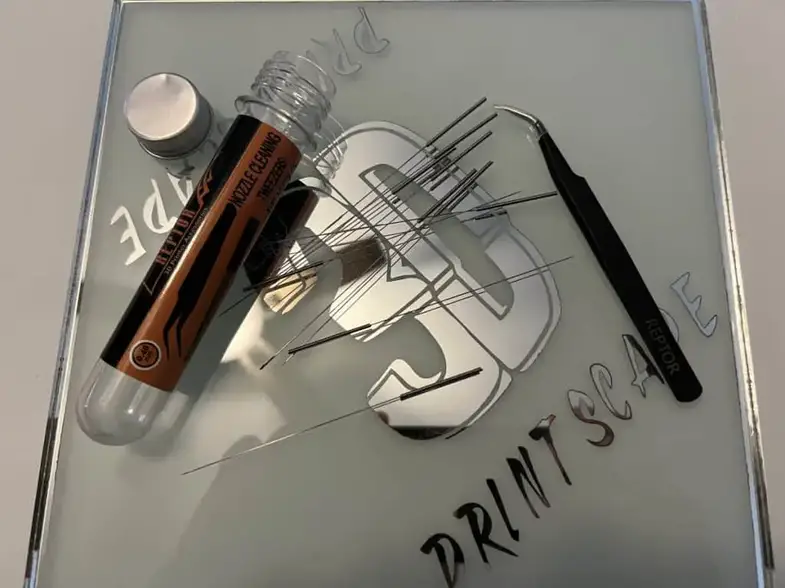6 Ways to Unclog and Clean a 3D Pen Nozzle
One frustration many new 3D pen users encounter is nozzle clogs. When melted plastic filament accumulates in or around the nozzle tip, it prevents normal extrusion.
This guide covers six effective unclogging and cleaning methods to remove obstructions and restore your 3D pen to smoothly flow again.
1. Remove Filament from Nozzle
If the 3D pen nozzle won’t extrude at all, the first step is removing any filament stuck inside. Start by heating the nozzle to your normal printing temperature.
Carefully grip the filament right above the nozzle and gently pull to coax it out. Twist the filament a bit as you pull if needed to break adhesion inside the opening.
Never forcefully yank on a jammed filament, as you can damage the nozzle. Be patient and allow the area to fully heat so the plastic melts and releases. Once removed, cut off the misshapen end before reinserting.
2. Clean Nozzle Tip Exterior
Even if the filament isn’t stuck inside, a clog can occur from the buildup around the nozzle exterior tip. Many 3D pens include a specialized metal pick tool for cleaning the nozzle.
Carefully poke the pick into the nozzle opening and scrape along the rim to dislodge any material clinging to the edges. Spinning the pick lets you polish all around the tip.
Avoid using metal pins, wires, or drill bits to clear nozzles, as these can easily enlarge the hole or scratch the smooth surface needed for clean flow.
3. Cold Pull Cleaning Method
For more stubborn interior clogs, try the popular cold pull cleaning technique.
First, preheat the nozzle just above the melting point. Load filament and allow it to partially soften inside the tip, then quickly pull it back out. The act of yanking out semi-molten filament can pull out residue clinging to the walls.
Repeat the cold pull process multiple times inserting filament a bit deeper each time until extrusion improves. Finish by cutting away any dirtied filament removed.

4. Clear with Fine Needle
If plastic debris is visible inside the nozzle tip, you may be able to dislodge it using a fine metal needle.
Insert the needle into the opening carefully and precisely poke at the obstruction, taking care not to forcefully jam the tool and widen the hole. Spinning and angling the needle as you insert can help clear out buildup along the inner walls.
Sewing needles, pin vices, or nozzle pick kits work well for this approach. Just take it slowly and gently.

5. Flush Nozzle with Atomizer Cleaners
Special plastic and resin 3D pen cleaning solutions can be purchased to flush out nozzle gunk. These atomized cleaner liquids dissolve or break up stuck filament scraps.
Load the cleaner fluid into the pen as you would normal filament. Heat the nozzle and extrude the cleaner through forcefully to flush away any particles inside. Let the excess liquid drain out and repeat if needed.
Cleaner fluids leave the inside of the nozzle pristine, but be sure to run regular filament through afterward to purge any remaining liquid residue.

6. Replace the Nozzle
3D pen nozzles are consumable components that degrade over time. If cleaning methods don’t restore normal flow, the nozzle may be too severely clogged or worn out.
Replacement nozzles are inexpensive and screw into most pen models easily. Upgrading to a wear-resistant hardened steel nozzle can grant a longer lifespan over standard brass tips.
Maintaining a spare nozzle on hand lets you quickly swap a fresh one in when prints start declining. A simple nozzle swap may get your 3D pen drawing smoothly again.

Prevent 3D Pens Clogging
Besides knowing the methods to clean up your 3D pen nozzle, you should also learn some ways to prevent this issue.
- Use high-quality filament – avoids inconsistencies that cause jams
- Wipe the pen with a damp cloth to prevent dust buildup
- Avoid low-quality filament with irregular diameters and contaminants
- Inspect filament and trim any defects on ends before loading
- Follow the recommended temperature and speed settings – too cold or fast increases risks
- Periodically clean the nozzle with the included tool to remove any debris
- Don’t overload the pen by pressing the filament too hard
FAQs
Q: What is the best way to clear a mild nozzle clog?
A: For minor clogs, simply purge the filament through the hot nozzle until the plastic flows cleanly again.
Q: How can I remove stubborn debris stuck in the nozzle?
A: Use the included cleaning rods, drill bits, or a thin wire to clear tough obstructions in a cold nozzle.
Q: What is the safest method to clean nozzle residue?
A: Disassembling the nozzle and soaking just the tip in isopropyl alcohol is the safest approach. Avoid acetone or abrasives.
See Also
PCL vs PLA 3D Pens: A Comparative Guide to Getting the Right 3D Pen









Add comment